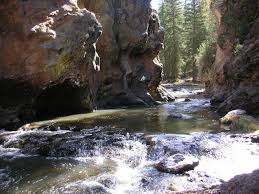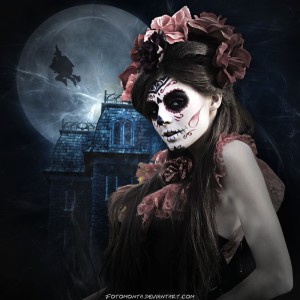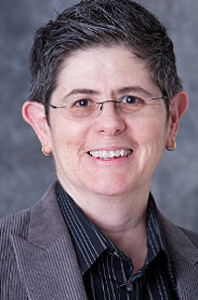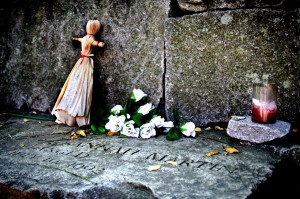
Image courtesy of: Adventure Insider Worldwide.
Jemez River East Fork.
In many ways, Bless me Ultima represents a rupture for Antonio from a safe, nurtured life with his family (especially his mother) to an outside world full of uncertainty and danger. He must go to school, where he forges a new identity-quite literally, when he is renamed Tony. He encounters bigger kids who use bad language and fight. He must contend with witnessing violence and murder and takes on his mother’s concern with remaining “innocent.” He is burdened with giving confession to a dying Narcisco. He inhabits the world of betwixt and between in other ways as well. He is caught between his mother’s Catholicism and her wishes for him to become a priest and his father’s wish that he become a vaquero. Though Antonio is conflicted, he most resembles and identifies with Ultima in that he senses the underlying supernatural elements of his world. He sees the golden carp and he senses the presence of the river, like Ultima does. It is Antonio that Ultima chooses to accompany her to heal Lucas. The golden carp sighting and Lucas’ healing underscored Antonio’s conflict best: if the golden carp is a new god, as Samuel believes, Antonio worries that his mother is praying to the wrong god. His faith comes into question again when both the doctor and the priest fail to cure Lucas, but Ultima succeeds. So while he witnesses these phenomena as an eyewitness, he can’t reconcile them with the idea of God as omnipotent. He also worries about Ultima’s powers, in that she uses them only for good or if it is possible that she could also be a bruja, as some of the townspeople believe.
This conflict not only plays out in spiritual terms, but culturally. In “Silence of the Liano,” Anaya discusses the same type of clash between the ranchers and the farmers from his own cultural history on the plains of New Mexico: ‘There was the obvious shock and turmoil which is always present when two different cultures meet; sometimes there was a sharing, many times bloodshed’ (Martin 134). This violence which ensues from cultural conflict is present in Bless Me, Ultima, but through acknowledging and contemplating the hybridity of the land, both characters learn to live within the land and within their own hybrid identities (Martin). This split is obvious to Antonio, even at his young age, which plays out in the tension between the Lunas and Marezs, primarily through his parents.
The landscape is a stand in for this dichotomy. Besides representing the tension between the Marezs and the Lunas, it represents the internal conflict that Antonio feels. When he begins school, a bridge separates him from the refuge of his home and the town. The river divides the llano and the village, both physically and culturally. It serves as both a source of comfort and of terror. It has presence, a soul and a magical quality but it also threatens to swallow the land because of the land’s sinners. Martin writes that, “the land acts as a catalyst to lead the character through a process that results in a reconciliation of the fragmented parts of his identity. Through contemplating the culturally hybrid nature of the land, the character develops a heightened awareness of the incongruity of the two cultures (Martin 147).
In some ways, for all of Antonio’s maturity, his view of the world is childlike. It is a world of absolutes without shades of grey, which is how children see the world, so his challenge is to reconcile these incongruities. In this way, Bless Me Ultima is a coming of age story. By the end of the novel, though, Antonio is able to imagine a third alternative that blends the two cultures. As Antonio is riding in the truck with his father, his father muses that everybody carries part of their past with them but that he can make something new, too. Antonio concludes, “Take the llano and the river valley, the moon and the sea, God and the golden carp-and make something new. That is what Ultima meant by building strength from life” (Anaya). Antonio forges his own identity and navigates his way between the two cultures much like the river navigates between Guadalupe and Las Pasturas.
Works Cited
Anaya, Rudolpho. Bless Me, Ultima. New York: Warner Books, 1972.
Martin, Holly E. “Hybrid Landscapes as Catalysts for Cultural Reconciliation in Leslie Marmon Silko’s “Ceremony” and Rudolpho Anaya’s “Bless Me Ultima”.” Atenea 26.1 (2006): 134.






